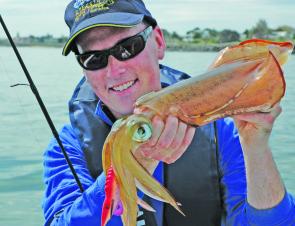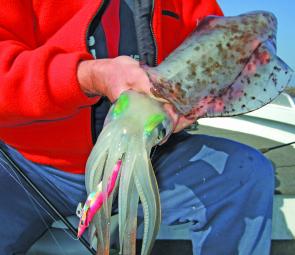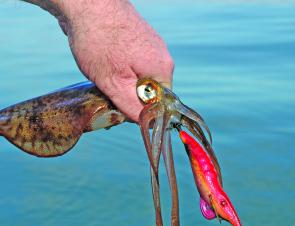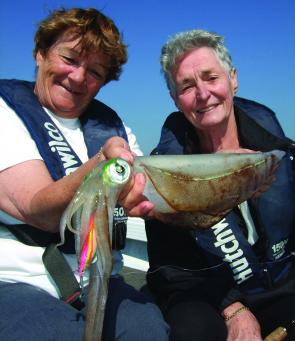Earlier this year, Victoria fisheries researchers conducted a Calamari Stock Assessment Workshop at the marine science facility at Queenscliff. Researchers from the Marine and Freshwater Fisheries Research Institute (MAFFRI) were joined by Fisheries Victoria managers, a Fisheries Officer, anglers, VRFish representatives, a fishing charter operator and several commercial fishers from Port Phillip Bay and Corner Inlet.
As the first stock assessment of calamari in Victoria, the workshop’s purpose was to review information on the biology and ecology of the species along with fishery information, including an examination of commercial and recreational fishing and trawl survey data. The workshop’s aim was to reach a consensus on the state of the stocks, fishery management implications and research needs.
Southern calamari occur around southern Australia and grow to 3.6kg and a body length of 55cm. They live for up to one year, with the oldest recorded individual aged at 291 days (calculated from daily growth rings on tiny statoliths on the balance organs).
Multiple spawnings occur through the breeding season, which accounts for the presence of several age groups of similar-sized calamari at various times during the year. Bunches of eggs are attached to seagrass and algae, in particular Amphibolus – a seagrass that has a stem carrying many small leaves and which occurs in extensive beds near the entrances to Port Phillip Bay, Western Port and other locations along the coast.
During spring, after developing in the egg for 30-60 days, small calamari emerge at night. In Port Phillip Bay, after reaching a body length of about 3cm they leave the shallow reef and seagrass beds and by March each year, MAFFRI’s trawl surveys find 5-10cm calamari spread throughout the Bay, including the deeper muddy basin. Later, at sizes over 15cm, they aggregate in the shallow waters where they are taken by targeted jig fishing and as a valued but incidental part of commercial haul seine catches. South Australian studies indicate that calamari are very adaptable, preying on a range of bottom and mid-water fish species.
During the early 1990s, annual recreational calamari catches in Port Phillip Bay were estimated at 55–96 tonnes, using a combination of survey methods. Phone diary surveys of recreational fishers have estimated approximately 50-65 tonnes were caught in 2000/01 and 45 tonnes in 2006/07. Most of the recreational calamari catch occurs in the southern part of the Bay, from Portarlington around to Dromana.
Calamari aggregate to spawn during spring and early summer and their life cycle is complete after spawning. Consequently, calamari taken during spring and early summer tend to be bigger (average 600g) than those taken in autumn (430g). Average yearly catch rates by anglers targeting calamari have been around 1 per hour since 1990.
Reported Victorian commercial calamari landings began slowly in around 1940 but rose to average 60 tonnes annually from the late 1950s until 2000, when they jumped to 70-100 tonnes. Of the 56 licensed Port Phillip and Western Port fishers, six catch more than half the annual commercial catch (40-60 tonnes) from these bays, with 87% taken in the multi-species haul seine fishery.
Highest catch rates occur from July to October. The largest catches come from the Geelong Arm and Lonsdale Bight with most of the remainder coming from the Bellarine Peninsula shores and southern Bay waters.
Along with the disappearance of extensive seagrass beds, reported annual landings from Western Port declined from 20 tonnes during the 1970’s to less than 8 tonnes since 2000, taken mainly around Hastings and French Island. Today, the second most productive part of the State is Corner Inlet where annual landings since 2000 have been 17-37 tonnes, taken mostly from the western basin area in seine nets between May and October.
Trends in yearly catch rates for Port Phillip, Western Port and Corner Inlet show a similar pattern, suggesting that common environmental factors are influencing yearly recruitment variations. Temperature, in particular, has a large influence on egg hatching rates and juvenile growth rates. As with most fast-growing, short-lived species, calamari numbers vary considerably from year to year. All of the information available from commercial and recreational fisheries monitoring, fishers’ observations and MAFFRI trawl surveys suggests that the Victorian stocks are in a healthy state.
The 1970’s decline in Western Port is clearly linked with seagrass loss there. Along with this, the apparent dependence of calamari spawning on limited and highly localised specific seagrass habitats indicates that protection of these habitats is critical to the future of these stocks. The workshop participants noted that valuable areas of calamari spawning habitat - and large numbers of adult calamari – are now protected by the Marine National Parks inside Port Phillip Heads.
Fast-growing and short-lived species can sustain high levels of fishing pressure. The calamari’s predictable habit of aggregating in accessible shallow areas makes them vulnerable to intensive fishing and their popularity among recreational fishers and seafood consumers has seen fishing pressure increase.
Commercial and recreational fishers at the workshop agreed that calamari numbers have been low during the past two seasons. While there is no current indication that Victoria’s calamari stocks need increased protection from fishing, in South Australia and Tasmania intensive fishing has resulted in localised depletions of spawning adults, requiring seasonal area closures.
MAFFRI and Fisheries Victoria will continue to closely monitor Victoria’s commercial and recreational fisheries. Along with commercial and recreational fishers they will also be on guard for any possible threats to critical calamari spawning habitats.
Facts
FURTHER INFORMATION
For a fact sheet all about calamari, visit the Fishcare website at www.fishcare.org.au
Calamari live for less than a year. They aggregate to spawn during spring and early summer.

Fast-growing and short-lived species can sustain high levels of fishing pressure. That’s just as well for species that are also great on the plate!

Calamari taken during spring and early summer tend to be bigger than those taken in autumn. Anglers catch around 1 per hour of fishing effort.

Recreational anglers take at least 45 tonnes of calamari in Victoria each year.






